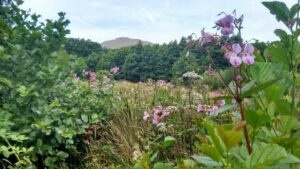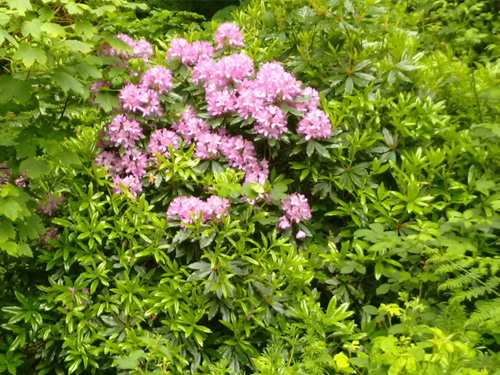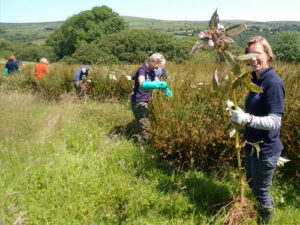Sustainable Stitch in Time 2023-2024
How do you solve the problem of Japanese knotweed and Himalayan balsam, the invasive species which threaten the natural landscape of the Pembrokeshire Coast National Park? Thanks to coordinated efforts between the Pembrokeshire Coast National Park Authority (PCNPA), communities and landowners over the past two years, these invasive non-native species (INNS) are being controlled with notable success
The PCNPA Stitch in Time project has seen working parties of volunteers and partners come together and work to clear Himalayan balsam from a number of sites across the National Park. The project – which was initially started in 2015 in Cwm Gwaun – has shown how a strategic approach can have a significant impact.
The original work in Cwm Gwaun resulted in 80% of the catchment land being managed using best practice methods with Himalayan balsam now classed as ‘near eradicated’ on the easterly tributaries. It takes two to four years for Himalayan balsam to be significantly reduced across a catchment landscape. Work needs to be coordinated and ongoing, particularly as Himalayan balsam has an ability to discharge thousands of seeds into the surrounding landscape and nearby waterways.

Throughout 2023 and 2024, the Stitch in Time project has been funded by the Heritage Lottery Fund with Matthew Tebbut acting as the Project Coordinator.
Matthew said:
“Himalayan balsam was initially thought to be uncontrollable, due to the sheer scale of the problem. However, it is now being effectively managed across various sites in Pembrokeshire through the Stitch in Time project. Collaboration with landowners and volunteers and the strategic allocation of contractor time has led to a significant reduction in densities of this invasive plant, fostering greater floral diversity.”
During the 2023/24 seasons, INNS control has focused on six main areas within the National Park: Castlemartin Corse SSSI (Castlemartin Corse catchment); Milford Haven Waterway SSSI (Pembroke, Holyland wood); Aberarth Carreg Wylan SSSI (Ceibwr, Moylegrove); Preseli SAC and Cleddau Rivers SAC (Afon Wern);Preseli SAC and North Pembrokeshire Woodlands SAC (Afon Nyfer- Crymych and Blaenffos headwaters and Brynberian sub-catchment); and North West Pembrokeshire Commons SAC and St. Davids SAC (Afon Alun St Davids).
Approximately 80 hectares of land remain in active Himalayan balsam control, supported by contractors, volunteers, and PCNPA staff. Volunteers are crucial to the project success and in the summer of 2024, 18 volunteer work parties were organised across project catchments, with sessions held at accessible sites like Castlemartin, St Davids, Crymych, and Blaenffos. During the 2024 control season, 143 individuals took part in the project, engaging in educational workshops and hands-on Himalayan balsam removal sessions. Mathew Tebbut has been key to organising community engagement as well as coordinating contractors, volunteers, and staff across various sites, with the project focused on Japanese knotweed, Himalayan balsam and rhododendron ponticum.
Key activities in 2023/24
- Surveying of Himalayan balsam and Japanese knotweed at all sites. Survey work at the Afon Wern catchment assessed potential risks by mapping infestations near its managed areas. The survey identified nearby balsam presence along roadsides and watercourses, as well as large infestations on private lands that may pose a future threat to managed sites.
- Provision of a monitoring plan for catchments based on the situation on the ground during winter and early spring of 2024/25.
- In summer 2024, 18 volunteer work parties were organised across project catchments, with sessions held at accessible sites like Castlemartin, St Davids, Crymych, and Blaenffos, chosen for ease of access, parking, and nearby facilities.
- During the past two years, volunteers contributed over 1,600 hours by cutting vegetation to increase access to land, cutting dead knotweed stems and prepping sites for balsam control.
- Japanese knotweed treatment in Afon Alun and Ceibwr – priority areas – has had a positive impact with Japanese knotweed significantly reduced during the project.
- Using guidance from the Pembrokeshire Nature Partnership’s priorities, contractors, project officers, and volunteers undertook regular site visits. As the 2024 season progressed, control measures focused more on hand-pulling, with minimal use of machinery, extending into late August and September.
- New ground surveys identified additional balsam infestations within the Ceibwr catchment and near Manorbier in the Pembroke catchment, marking these areas for targeted control during the upcoming seasons.
- Swift action at the start of 2024 resulted in the near eradication of Himalayan balsam at the Dale site thus safeguarding surrounding habitats by preventing further spread.
- Three events were held in Spring 2024 including a Walk and Talk at Canaston Woods with the Pembrokeshire Coast Charitable Trust, and two best practice workshops were held with West Wales River Trust, attracting 36 members of the public.
- PCNPA North Rangers identified several rhododendron ponticum plants establishing at Penlan (a PCNPA-owned site formerly a conifer plantation, now heathland). These were cut and treated to prevent further spread. Future monitoring will be undertaken by PCNPA.

Outcomes
- The findings from the Afon Wern survey will provide essential data for planning future projects focused on protecting the Afon Wern and surrounding areas from invasive species spread. These insights will help prioritize buffer zones and guide targeted control efforts in vulnerable locations.
- As control entered its second season, balsam densities visibly decreased, allowing native plants such as foxglove and pink campion to re-establish and form new seed banks. The Project Coordinator has documented these improvements with fixed-point photos and status maps, showing the positive impact of active management.
- Knotweed control is crucial for biosecurity, preventing spread through common land use and making these areas more resilient to future invasion. Through effective management and community-focused strategies, the Project Coordinator has ensured that sites are progressively restored, requiring less intensive intervention over time.
- Catchment specific maps show the control status, using colour codes for clear tracking. Current status maps for Castlemartin, Ceibwr, Wern, St Davids, and Waterwynch catchments have been completed and illustrate the progress.
- At Ceibwr, this area is now a priority for Himalayan balsam control, as the reduction in knotweed has triggered the balsam seedbank to germinate. Due to the presence of knotweed, the balsam cannot be strimmed; therefore, control efforts in the 2025 season will require cutting with hand tools only.
Celebrating the volunteers
Volunteers have been crucial to the success of the Stitch in Time project. This project actively seeks to expand its volunteer base by reaching new audiences and welcoming individuals from diverse backgrounds. Public volunteer days reached almost full attendance and introduced the
project’s goals to people unfamiliar with conservation work, inviting them to learn and engage in hands-on activities. One volunteer commented:
“We have made a huge impact in the reduction of Himalayan balsam in the areas where we have been focusing our efforts. Regular weekly fortnightly sessions have kept the balsam down and we can see areas that were once densely covered now flourishing with other native plants.”
To encourage as many volunteers as possible, the project has supplied tools and wet-weather gear, while travel expenses have been offered to support continued involvement. In return, volunteers gain hands-on experience and learn control techniques they can apply in their own green spaces, further strengthening local conservation efforts.
In preparation for ongoing volunteer engagement, the project has run first aid training courses to enhance safety and preparedness during fieldwork. To support upcoming winter
activities, essential tools such as shears and gloves have also been ordered alongside wet weather gear, including waterproof clothing for both volunteers and the project officer, in response to persistent wet conditions.

Future plans
As this two-year phase of the Stitch in Time project draws to a close, the work is by no means over. Looking ahead, the project will maintain partnerships with local contractors and expand these relationships as project needs grow.
In the original Gwaun catchment, monitoring is continuing with any outbreaks being targeted swiftly following the catchment approach of a source to sea.
Notably, the Authority will have to factor in the impacts of climate change as large storm events become more frequent. Storm Darragh caused significant damage to sites, particularly in the Castlemartin catchment, due to fallen trees. The agreed budget and volunteer input during the next balsam control season could impact progress.
The site at Ceibwr has secured funding for the necessary future work. In addition, PCNPA is committed to continuing work at this site and in other catchment areas not yet covered by external grants for 2025 and beyond.